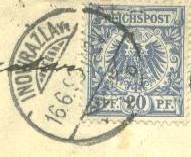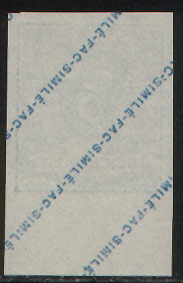


Return To Catalogue - 1875-1888 issues - 1900-1920 'Germania' issues - 1900-1920 other issues - Germany overview
Note: on my website many of the
pictures can not be seen! They are of course present in the cd's;
contact me if you want to purchase them: evert@klaseboer.com.
Crown 2 p grey (1900) 3 p brown 5 p green Eagle
10 p red 20 p blue 25 p orange 50 p brown
Value of the stamps |
|||
vc = very common c = common * = not so common ** = uncommon |
*** = very uncommon R = rare RR = very rare RRR = extremely rare |
||
| Value | Unused | Used | Remarks |
| 2 p | c | c | for local use, issued 1 April 1900 |
| 3 p | c | vc | shades |
| 5 p | * | vc | |
| 10 p | * | vc | Issued 1 October 1889 |
| 20 p | * | vc | |
| 25 p | ** | c | |
| 50 p | *** | vc | |

(3 p deep brown)
For the specialist: these stamps were perforated 13 1/2 x 14 1/2. The 3 p brown exists from yellowish brown to very deep brown. The 2 p grey was introduced to replace the many local stamps that were forbidden after 1st April 1900. These stamps were printed in sheets of 400 stamps.
Imperforate stamps: the following text can be found at http://www.gps.nu/pub/anniversary/page21.html concerning imperforate stamps "Having saved them in the archives only to take them out again to pay the debt owed by the Imperial Postal Museum to the forenamed Kosack, who began offering them to collectors in the following year" (Philip Kosack was a Berlin stamp dealer).
Typical cancels, example:

(Reduced size)
Overprinted with 'PARA' or 'PIASTER' for use in Turkey.



(Overprinted 'Para' and value) - (Overprinted 'Marocco' and
value)
Stamps overprinted 'China' for use in China.

(Overprinted 'China', reduced sizes)
Oveprints in 'PESA' were used in German East Africa.
Four different postal forgeries of the 10 p red are known from the towns of Höchst, Hanover, Rixdorf and Dresden. I have not many pictures available right now. If anybody has pictures of these forgeries, please contact me! The Rixdorf forgery was made by the printer Julius Rose and has perforation 10 1/2, source: 'Germany and it Colonies' by Bertram W.H.Poole.

So-called "Höchster Postfälschung" from 1890, image
obtained from http://www.klassische-philatelie.ch/intro_nd.html.
The printer of the forgeries, the Bauer Brothers, were arrested
in January 1891.

Dresden postal forgery ("Dresdener Postfälschung”),
The forgery was made by L. Heys, J.G. Bönhardt and C.T. Wagner
and put into circulation by L. Heys. Due to the bad quality it
was discovered just a few hours later and the forgers were
arrested. Only a few stamps have done 'duty'.
The forger Fournier made forgeries of the 1889 issue (all values except the 2 p). He mainly used them to create forged overprinted German Colonies stamps, but he also seems to have made imperforate German stamps. I have seen a 5 p of these imperforate stamps, also, pictures can be found in 'The Fournier Album of Philatelic Forgeries'.

Page of a Fournier Album with forgeries and forged cancels of
Germany, reduced sizes


Front and backside of a 5 p Fournier forgery from the Fournier
Album; this one has 'FAC-SIMILE' printed on the backside.


(Fournier forgeries, with overprints of 'Deutsch Neu-Guinea')
In my opinion, the easiest way to distinguish them from genuine stamps, is to look at the perforation in the corners, the horizontal and vertical perforation does not 'match' as it does in the genuine stamps.

Forged Fournier cancels as found in a Fournier Album.
The following cancels (I suppose to be used on
imperforate forgeries) can be found in the Fournier Album of
Philatelic Forgeries (as shown above):
"NEUHAUS 3 1 AM RENNWEG" in a single circle
"MAINZ 11 8 74 1-5 N." in a single circle
"BERLIN P.E.No1 2/11 64 12-1N" in a double circle
"N FRANKFURT A.M 2 5/7 72 2-3N." in a single circle.

(Imperforate 10 p forgery, probably from the same forger)


(And some other 'products', made in whole sheets, from the same
source?)
The forger Peter Winter has also made forgeries of at least the 10 p and 20 p values. As in the Fournier forgeries, the horizontal and vertical perforation does not match. I have also seen imperforate forgeries of the 10 p and 20 p values (I have even seen a complete sheet of 5 rows of 9 imperforate 20 p stamps). I've also seen two attached 20 p stamp, both imperforate, but one is 'misperfated' diagonally. He seems to have used these stamps mainly to create the rare provisional overprints used in China and possibly also some German colonies overprints. Since these forgeries were made quite recently (1980's), the forgeries don't look very 'old'. I've also seen a imperforate 10 p red tete-beche (large space in between) with a 20 p red (wrong colour!).

Mystery item resembling a 5 p green stamp, but the design is
slightly different. Also the cancel is very small ('KOLN RHEIN 2
12 91 5 1 V').
Postcards in the same design (here with railway cancel 'BAHNPOST'):
I've also seen cuts of postal stationary in the
values 2 p grey, 3 p brown and 10 p red.
A 30 p blue (non-issued for the stamps!) exists for the tube
postal system of Berlin (Rohrpost).

(Essay of the 20 p blue, reduced size)


Essays in a different design, printed in a minisheet.
Germany 1900-1920 'Germania'
issues
Germany 1900-1920 other issues
Die Postfälschungen des Dt. Kaiserreiches, Jäschke-Lantelme, (postal forgeries of the German empire, in German), 120 pages
Stamps - Briefmarken - Timbres-Poste